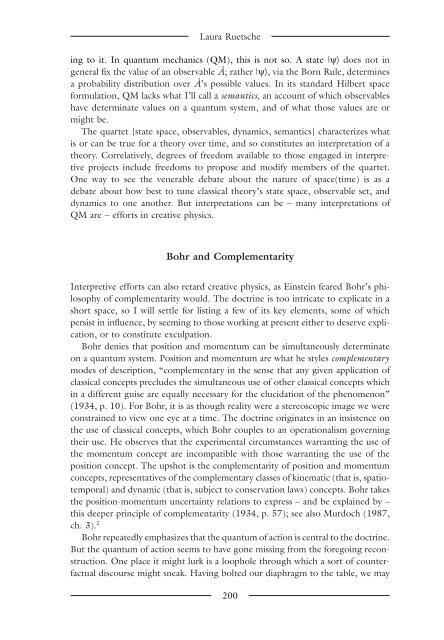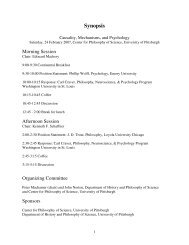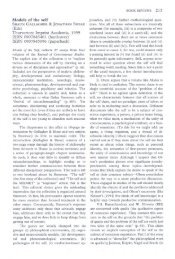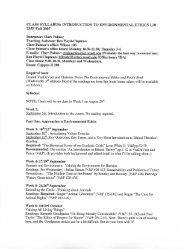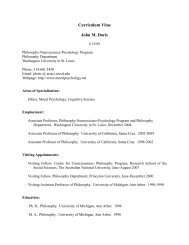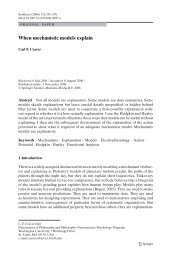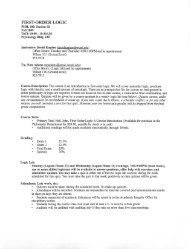The Blackwell Guide to the Philosophy of Science - The Department ...
The Blackwell Guide to the Philosophy of Science - The Department ...
The Blackwell Guide to the Philosophy of Science - The Department ...
Create successful ePaper yourself
Turn your PDF publications into a flip-book with our unique Google optimized e-Paper software.
Laura Ruetsche<br />
ing <strong>to</strong> it. In quantum mechanics (QM), this is not so. A state |yÒ does not in<br />
general fix <strong>the</strong> value <strong>of</strong> an observable Â; ra<strong>the</strong>r |yÒ, via <strong>the</strong> Born Rule, determines<br />
a probability distribution over Â’s possible values. In its standard Hilbert space<br />
formulation, QM lacks what I’ll call a semantics, an account <strong>of</strong> which observables<br />
have determinate values on a quantum system, and <strong>of</strong> what those values are or<br />
might be.<br />
<strong>The</strong> quartet {state space, observables, dynamics, semantics} characterizes what<br />
is or can be true for a <strong>the</strong>ory over time, and so constitutes an interpretation <strong>of</strong> a<br />
<strong>the</strong>ory. Correlatively, degrees <strong>of</strong> freedom available <strong>to</strong> those engaged in interpretive<br />
projects include freedoms <strong>to</strong> propose and modify members <strong>of</strong> <strong>the</strong> quartet.<br />
One way <strong>to</strong> see <strong>the</strong> venerable debate about <strong>the</strong> nature <strong>of</strong> space(time) is as a<br />
debate about how best <strong>to</strong> tune classical <strong>the</strong>ory’s state space, observable set, and<br />
dynamics <strong>to</strong> one ano<strong>the</strong>r. But interpretations can be – many interpretations <strong>of</strong><br />
QM are – efforts in creative physics.<br />
Bohr and Complementarity<br />
Interpretive efforts can also retard creative physics, as Einstein feared Bohr’s philosophy<br />
<strong>of</strong> complementarity would. <strong>The</strong> doctrine is <strong>to</strong>o intricate <strong>to</strong> explicate in a<br />
short space, so I will settle for listing a few <strong>of</strong> its key elements, some <strong>of</strong> which<br />
persist in influence, by seeming <strong>to</strong> those working at present ei<strong>the</strong>r <strong>to</strong> deserve explication,<br />
or <strong>to</strong> constitute exculpation.<br />
Bohr denies that position and momentum can be simultaneously determinate<br />
on a quantum system. Position and momentum are what he styles complementary<br />
modes <strong>of</strong> description, “complementary in <strong>the</strong> sense that any given application <strong>of</strong><br />
classical concepts precludes <strong>the</strong> simultaneous use <strong>of</strong> o<strong>the</strong>r classical concepts which<br />
in a different guise are equally necessary for <strong>the</strong> elucidation <strong>of</strong> <strong>the</strong> phenomenon”<br />
(1934, p. 10). For Bohr, it is as though reality were a stereoscopic image we were<br />
constrained <strong>to</strong> view one eye at a time. <strong>The</strong> doctrine originates in an insistence on<br />
<strong>the</strong> use <strong>of</strong> classical concepts, which Bohr couples <strong>to</strong> an operationalism governing<br />
<strong>the</strong>ir use. He observes that <strong>the</strong> experimental circumstances warranting <strong>the</strong> use <strong>of</strong><br />
<strong>the</strong> momentum concept are incompatible with those warranting <strong>the</strong> use <strong>of</strong> <strong>the</strong><br />
position concept. <strong>The</strong> upshot is <strong>the</strong> complementarity <strong>of</strong> position and momentum<br />
concepts, representatives <strong>of</strong> <strong>the</strong> complementary classes <strong>of</strong> kinematic (that is, spatiotemporal)<br />
and dynamic (that is, subject <strong>to</strong> conservation laws) concepts. Bohr takes<br />
<strong>the</strong> position-momentum uncertainty relations <strong>to</strong> express – and be explained by –<br />
this deeper principle <strong>of</strong> complementarity (1934, p. 57); see also Murdoch (1987,<br />
ch. 3). 2<br />
Bohr repeatedly emphasizes that <strong>the</strong> quantum <strong>of</strong> action is central <strong>to</strong> <strong>the</strong> doctrine.<br />
But <strong>the</strong> quantum <strong>of</strong> action seems <strong>to</strong> have gone missing from <strong>the</strong> foregoing reconstruction.<br />
One place it might lurk is a loophole through which a sort <strong>of</strong> counterfactual<br />
discourse might sneak. Having bolted our diaphragm <strong>to</strong> <strong>the</strong> table, we may<br />
200


